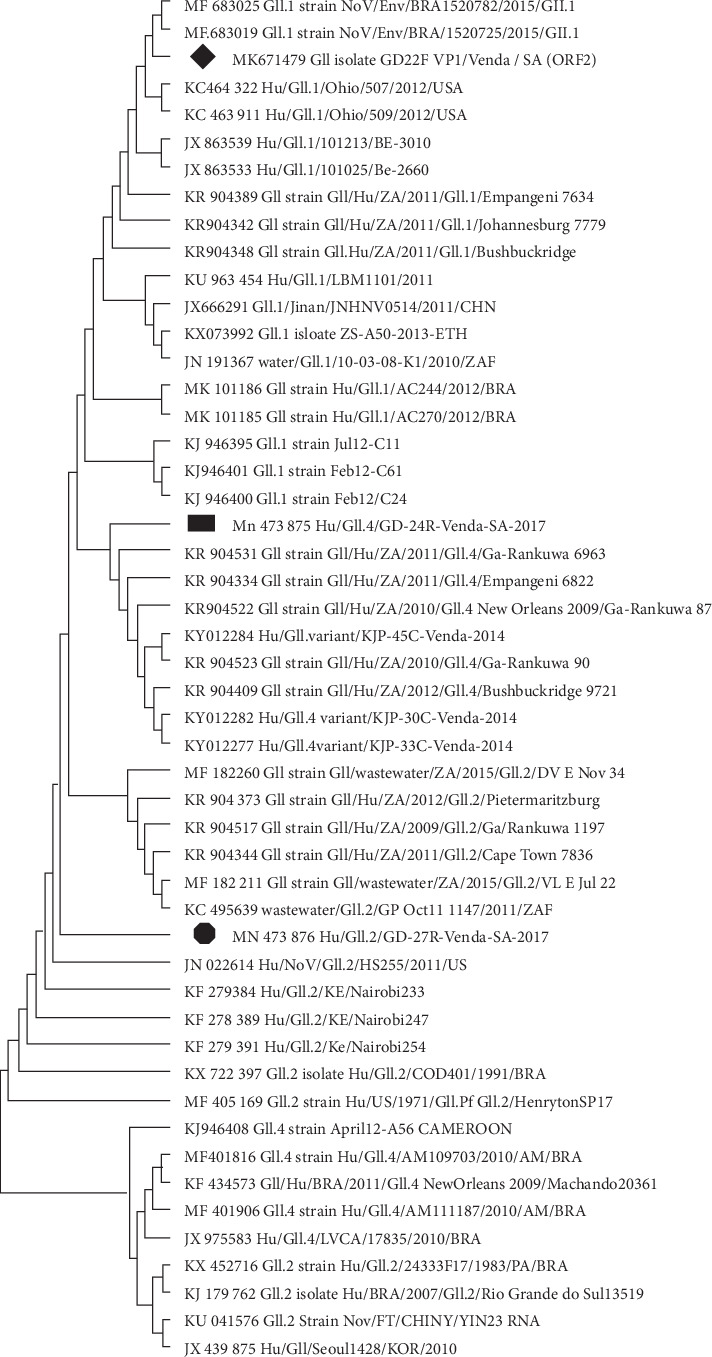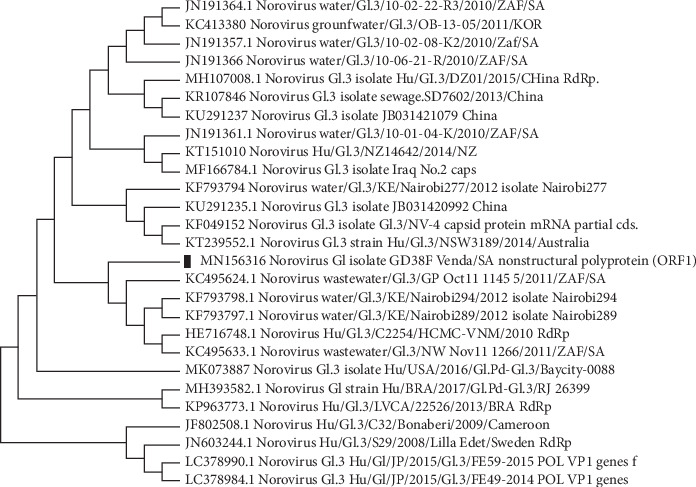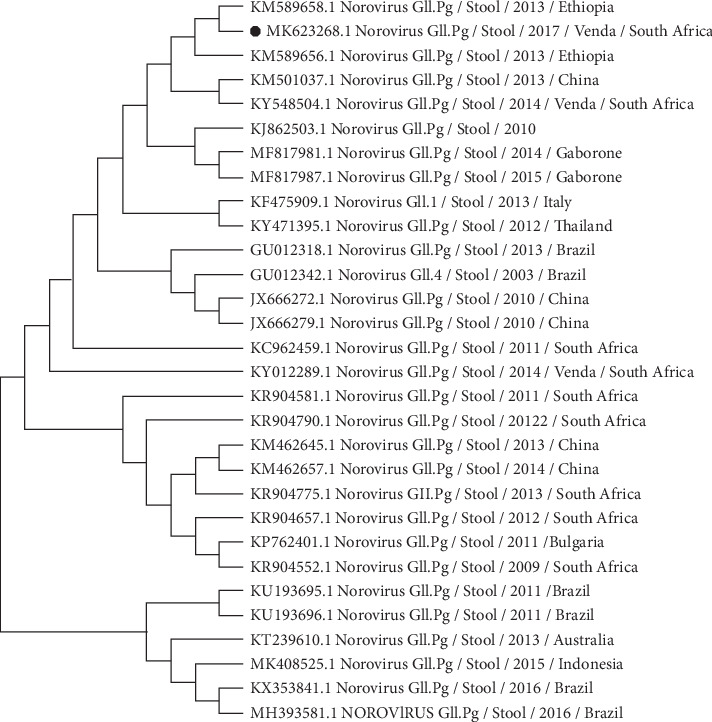下载PDF
{"title":"南非Vhembe地区贫困社区大龄儿童和成人诺如病毒分离株的分子特征","authors":"G Mulondo, R Khumela, J P Kabue, A N Traore, N Potgieter","doi":"10.1155/2020/8436951","DOIUrl":null,"url":null,"abstract":"<p><strong>Background: </strong>Human norovirus (NoV) is an etiological agent associated with acute gastroenteritis (AGE) in both children and adults worldwide. However, very few studies have been reported on the prevalence and genetic diversity of NoV strains in children older than 5 years of age and adults with little or inadequate water and sanitation conditions.</p><p><strong>Objectives: </strong>The aim of this study was assessing the prevalence of the human norovirus in older children and adults suffering with diarrhoea from rural communities in the Vhembe district, Limpopo province.</p><p><strong>Methods: </strong>Between August 2017 and October 2018, stool samples were collected from outpatients suffering from AGE and screened for NoV strains using the RIDA©GENE norovirus I and II real-time one-step RT-PCR. RNA extracts of NoV-positive samples were subjected to RT-PCR amplification and nucleotide sequencing to genotype the positive NoV strains.</p><p><strong>Results: </strong>Out of 80 collected stool samples, 13 (16%) were tested positive for norovirus. Genogroup GII was identified in 6/13 (46%) samples and genogroup GI in 7/13 (54%) samples. The sequence analyses showed multiple genotypes including GII.Pg, GII.1, GII.2, GII.4, and GI.3. Phylogenetic analysis revealed the relatedness of NoV genotypes identified with other strains reported globally.</p><p><strong>Conclusion: </strong>Continued systematic surveillance to evaluate norovirus association with diarrhoea is needed to assist with epidemiological surveillance and disease burden in people of all the age groups.</p>","PeriodicalId":7473,"journal":{"name":"Advances in Virology","volume":"2020 ","pages":"8436951"},"PeriodicalIF":1.4000,"publicationDate":"2020-06-29","publicationTypes":"Journal Article","fieldsOfStudy":null,"isOpenAccess":false,"openAccessPdf":"https://sci-hub-pdf.com/10.1155/2020/8436951","citationCount":"5","resultStr":"{\"title\":\"Molecular Characterization of Norovirus Strains Isolated from Older Children and Adults in Impoverished Communities of Vhembe District, South Africa.\",\"authors\":\"G Mulondo, R Khumela, J P Kabue, A N Traore, N Potgieter\",\"doi\":\"10.1155/2020/8436951\",\"DOIUrl\":null,\"url\":null,\"abstract\":\"<p><strong>Background: </strong>Human norovirus (NoV) is an etiological agent associated with acute gastroenteritis (AGE) in both children and adults worldwide. However, very few studies have been reported on the prevalence and genetic diversity of NoV strains in children older than 5 years of age and adults with little or inadequate water and sanitation conditions.</p><p><strong>Objectives: </strong>The aim of this study was assessing the prevalence of the human norovirus in older children and adults suffering with diarrhoea from rural communities in the Vhembe district, Limpopo province.</p><p><strong>Methods: </strong>Between August 2017 and October 2018, stool samples were collected from outpatients suffering from AGE and screened for NoV strains using the RIDA©GENE norovirus I and II real-time one-step RT-PCR. RNA extracts of NoV-positive samples were subjected to RT-PCR amplification and nucleotide sequencing to genotype the positive NoV strains.</p><p><strong>Results: </strong>Out of 80 collected stool samples, 13 (16%) were tested positive for norovirus. Genogroup GII was identified in 6/13 (46%) samples and genogroup GI in 7/13 (54%) samples. The sequence analyses showed multiple genotypes including GII.Pg, GII.1, GII.2, GII.4, and GI.3. Phylogenetic analysis revealed the relatedness of NoV genotypes identified with other strains reported globally.</p><p><strong>Conclusion: </strong>Continued systematic surveillance to evaluate norovirus association with diarrhoea is needed to assist with epidemiological surveillance and disease burden in people of all the age groups.</p>\",\"PeriodicalId\":7473,\"journal\":{\"name\":\"Advances in Virology\",\"volume\":\"2020 \",\"pages\":\"8436951\"},\"PeriodicalIF\":1.4000,\"publicationDate\":\"2020-06-29\",\"publicationTypes\":\"Journal Article\",\"fieldsOfStudy\":null,\"isOpenAccess\":false,\"openAccessPdf\":\"https://sci-hub-pdf.com/10.1155/2020/8436951\",\"citationCount\":\"5\",\"resultStr\":null,\"platform\":\"Semanticscholar\",\"paperid\":null,\"PeriodicalName\":\"Advances in Virology\",\"FirstCategoryId\":\"1085\",\"ListUrlMain\":\"https://doi.org/10.1155/2020/8436951\",\"RegionNum\":0,\"RegionCategory\":null,\"ArticlePicture\":[],\"TitleCN\":null,\"AbstractTextCN\":null,\"PMCID\":null,\"EPubDate\":\"2020/1/1 0:00:00\",\"PubModel\":\"eCollection\",\"JCR\":\"Q4\",\"JCRName\":\"VIROLOGY\",\"Score\":null,\"Total\":0}","platform":"Semanticscholar","paperid":null,"PeriodicalName":"Advances in Virology","FirstCategoryId":"1085","ListUrlMain":"https://doi.org/10.1155/2020/8436951","RegionNum":0,"RegionCategory":null,"ArticlePicture":[],"TitleCN":null,"AbstractTextCN":null,"PMCID":null,"EPubDate":"2020/1/1 0:00:00","PubModel":"eCollection","JCR":"Q4","JCRName":"VIROLOGY","Score":null,"Total":0}
引用次数: 5
引用
批量引用
Molecular Characterization of Norovirus Strains Isolated from Older Children and Adults in Impoverished Communities of Vhembe District, South Africa.
Background: Human norovirus (NoV) is an etiological agent associated with acute gastroenteritis (AGE) in both children and adults worldwide. However, very few studies have been reported on the prevalence and genetic diversity of NoV strains in children older than 5 years of age and adults with little or inadequate water and sanitation conditions.
Objectives: The aim of this study was assessing the prevalence of the human norovirus in older children and adults suffering with diarrhoea from rural communities in the Vhembe district, Limpopo province.
Methods: Between August 2017 and October 2018, stool samples were collected from outpatients suffering from AGE and screened for NoV strains using the RIDA©GENE norovirus I and II real-time one-step RT-PCR. RNA extracts of NoV-positive samples were subjected to RT-PCR amplification and nucleotide sequencing to genotype the positive NoV strains.
Results: Out of 80 collected stool samples, 13 (16%) were tested positive for norovirus. Genogroup GII was identified in 6/13 (46%) samples and genogroup GI in 7/13 (54%) samples. The sequence analyses showed multiple genotypes including GII.Pg, GII.1, GII.2, GII.4, and GI.3. Phylogenetic analysis revealed the relatedness of NoV genotypes identified with other strains reported globally.
Conclusion: Continued systematic surveillance to evaluate norovirus association with diarrhoea is needed to assist with epidemiological surveillance and disease burden in people of all the age groups.




 求助内容:
求助内容: 应助结果提醒方式:
应助结果提醒方式:


